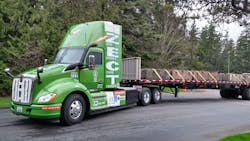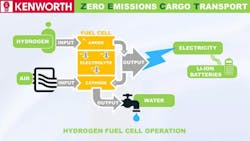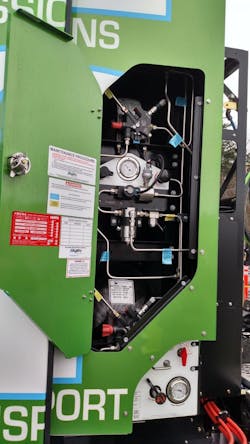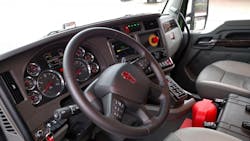T680 Prototype Runs on Fuel Cell, Batteries
Although its fuel cell/electric heavy truck is still early in its development phase, Kenworth Truck nonetheless showed it to reporters and let them drive it, far ahead of similar vehicles introduced with much fanfare, including visionary and media darling Elon Musk and his Tesla Semi-Truck. From whatever source, electric propulsion, as in this tractor, could well be the future of on-road hauling and perhaps on/off-road vocational trucks, at least in areas where authorities are demanding ever-lower exhaust emissions.
Called Zero Emissions Cargo Transport, or ZECT, the highly modified T680 daycab tractor has a hydrogen fuel cell and electric motor instead of a diesel. The cell produces high-voltage DC electricity that is fed to the battery pack and, inverted to AC, to the motor. This sends horsepower and torque through a 4-speed automated transmission to conventional tandem rear axles.
Short drives of the ZECT tractor pulling loaded trailers at the Paccar Technical Center near Mt. Vernon, Wash., showed near-silent operation punctuated by whirring of the motor and slight crunching of the gearbox as it upshifted under acceleration. Cooling fans came on as needed, but did little to spoil an almost overwhelming serenity.
“Quietness is good for the driver but not so good for a manufacturer,” he said wryly as I pulled onto a county road from the tech center’s entrance. “You start to hear things that you didn’t hear before, like rattles and squeaking panels in the interior.”
There was a bit of that while under full throttle, and some low-pitched vibration seemed to come from the driveline, maybe a maladjusted U-joint, I guessed. “We are early in tuning the inverters to the motors, and we believe the vibration can be cleaned up with better tuning,” he said.
Performance was brisk at start out but only adequate thereafter, because output was limited to about 300 horsepower, a little more than half the motor’s 560-horsepower rating. This was done to protect the transmission until shifting logic in its electronic controls is worked out, Lindgren said. The motor spun much faster than a diesel, operating at 2,000 to 3,750 rpm, according to the tachometer. It could go to 6,000 rpm, but Eaton wanted it limited to 4,000 to protect the transmission, which is actually the “back box” of an 18-speed.
Top speed is 65 mph, but short straight-aways and several curves on our route limited our velocity to about 45 mph, just after the tranny shifted into 4th gear. I had my throttle foot to the floor much of the time due to the limited power output. With my foot off the pedal, though, regeneration started and slowed the rig gently or aggressively, depending on how the rocker switch on the dash was set. “It’s like a Jake Brake,” Lindgren said as he changed the switch from off to 1, 2, or 3. When on 3 and at low speeds, regen will almost stop the truck.
(Right: Six pressurized tanks carry 30 kilograms of hydrogen, enough to fuel the cell for 150 miles.)
The fuel cell operates almost silently, and nothing from it can be heard inside the cab. The cell makes electricity by sending hydrogen molecules through membranes that split off electrons and send them to the battery pack. What’s left are protons, which combine with the oxygen from inlet air to produce the water vapor. Such clean exhaust is what appeals to clean air authorities in California, where this truck will operate.
The green T680 ZECT represents about $7 million in material and development costs, Lindgren said. That covers the somewhat exotic powertrain components: Ballard cell; Xalta lithium-ion battery pack; Borg-Warner motor; numerous fans, pumps, and heat exchangers from various sources; and electronic controls assembled by Kenworth and BAE Systems engineers. The work has been tricky but is going quickly. It has required the building of relationships among representatives of the various suppliers, some of whom KW people have not worked with before. What this kind of truck would cost with volume production is anybody’s guess.
An operational drawback is the truck’s tare weight of about 22,000 pounds, or 6,000 pounds more than a standard diesel-powered daycab T680, Lindgren said. That weight penalty is expected to come down as advances are made in lithium-ion batteries and other components. The battery pack alone weighs 2,000 pounds, and the fuel cell and accessory hardware add up to about 1,500 pounds. In addition to the large driveline motor, smaller motors run the truck’s air compressor, power steering, and air conditioning compressor.
Much of the development is being funded by the U.S. Department of Energy, California Energy Commission, and South Coast Air Quality Management District. Southern California is where the tractor will work, pulling cargo containers out of the ports of Los Angeles and Long Beach. It’s slated to be turned over to Total Transportation Systems, a drayage operator that has run other prototype tractors, including another hydrogen fuel cell/electric tractor that I rode in several years ago.
A battery/electric powertrain is another way to achieve the zero emissions wanted by California authorities, but such trucks have limited range. The fuel cell is a “range extender,” lengthening a truck’s operating radius from the ports. It could run about 150 miles before the pressurized hydrogen tanks behind the cab need to be replenished. Hydrogen was chosen because it’s “sustainable.” It’s the most abundant element in the universe, even if extracting it from whatever source takes some effort. And as we’ve noted, the cell emits no pollutants.
Will a fuel cell hold up in a vocational truck?
“We’re going to find out,” said Lindgren during an introductory briefing for reporters. “They’re OK for buses. About 200 of them are now being used in transit buses, which bump along on city streets. Are they OK for construction trucks? We don’t know yet.”



